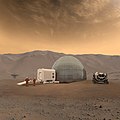Human mission to Mars
A human mission to Mars has been seen in science fiction since the 1880s, and of aerospace engineering and scientific proposals since the late 1940s.
Plans include landing on Mars for exploration at a minimum, with some thinking about exploring its moons Phobos and Deimos.
Long term proposals have included sending settlers and starting terraforming the planet.
The exploration of Mars has been a goal of national space programs for many years with planned missions typically being stated as taking place anywhere between 10 and 30 years.
Plans for a human mission to Mars may include a small group (between two and eight astronauts) would visit Mars for a period of a few weeks or year.[1]
Landed spacecraft on the surface of Mars are: Mars 3, Viking 1, Viking 2, Mars Pathfinder and Sojourner, Spirit, Opportunity, Phoenix, Curiosity, InSight, Beagle2 and Perseverance.
In April 2021, the Mars Oxygen ISRU Experiment was able to create oxygen in the Martian atmosphere by using carbon dioxide.[2] Many believe this is the first step for a human mission to Mars as it will help humans create breathable oxygen.[2]
Human Mission To Mars Media
The minimum distance between the orbits of Mars and Earth from 2014 to 2061, measured in astronomical units
Artistic vision of spacecraft providing artificial gravity by spinning (see also Centrifugal force)
Depiction of plants growing in a Mars base. NASA plans to grow plants for space food.
References
- ↑ Von Drehle, David (15 December 2020). Humans don't have to set foot on Mars to visit it. https://www.washingtonpost.com/opinions/humans-dont-have-to-set-foot-on-mars-to-visit-it/2020/12/15/b1df2afe-3f05-11eb-9453-fc36ba051781_story.html. Retrieved 16 December 2020.
- ↑ 2.0 2.1 Potter, Sean (2021-04-21). "NASA's Perseverance Mars Rover Extracts First Oxygen from Red Planet". NASA. Archived from the original on 2021-04-22. Retrieved 2021-04-22.







